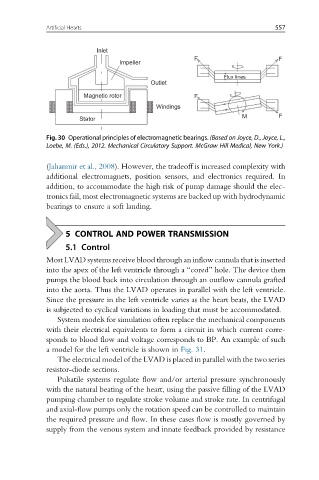Page 564 - Handbook of Biomechatronics
P. 564
Artificial Hearts 557
Inlet
F F
Impeller
Flux lines
Outlet
Magnetic rotor F
Windings
Stator M F
Fig. 30 Operational principles of electromagnetic bearings. (Based on Joyce, D., Joyce, L.,
Loebe, M. (Eds.), 2012. Mechanical Circulatory Support. McGraw Hill Medical, New York.)
(Jahanmir et al., 2008). However, the tradeoff is increased complexity with
additional electromagnets, position sensors, and electronics required. In
addition, to accommodate the high risk of pump damage should the elec-
tronics fail, most electromagnetic systems are backed up with hydrodynamic
bearings to ensure a soft landing.
5 CONTROL AND POWER TRANSMISSION
5.1 Control
Most LVAD systems receive blood through an inflow cannula that is inserted
into the apex of the left ventricle through a “cored” hole. The device then
pumps the blood back into circulation through an outflow cannula grafted
into the aorta. Thus the LVAD operates in parallel with the left ventricle.
Since the pressure in the left ventricle varies as the heart beats, the LVAD
is subjected to cyclical variations in loading that must be accommodated.
System models for simulation often replace the mechanical components
with their electrical equivalents to form a circuit in which current corre-
sponds to blood flow and voltage corresponds to BP. An example of such
a model for the left ventricle is shown in Fig. 31.
The electrical model of the LVAD is placed in parallel with the two series
resistor-diode sections.
Pulsatile systems regulate flow and/or arterial pressure synchronously
with the natural beating of the heart, using the passive filling of the LVAD
pumping chamber to regulate stroke volume and stroke rate. In centrifugal
and axial-flow pumps only the rotation speed can be controlled to maintain
the required pressure and flow. In these cases flow is mostly governed by
supply from the venous system and innate feedback provided by resistance

